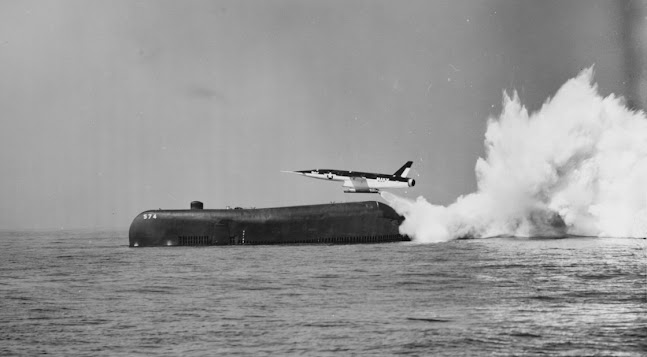 |
The first REGULUS II is launched from US Navy submarine USS GRAYBACK (SSG 574) in the Pacific, 17 September 1958. |
Review by Bill Doughty––
U.S. Naval Institute Press has another winner in “Strike from the Sea: The Development and Deployment of Strategic Cruise Missiles Since 1934” by Norman Polmar and John O’Connell (2020). This carefully researched and documented book –– filled with photos, diagrams, statistics, and appendices –– presents a history of some of the world’s most dangerous tools of war.Told from an American and largely U.S. Navy perspective, "Strike from the Sea" shows the development of Regulus and Regulus II, Rigel, Triton, Polaris, Vertical Launch Tubes, Tomahawk, and the Virginia Payload Module, among others. (Below, painting of an undersea ballistic missile by Walter H. Bollendonk from 1961 “Polaris Underwater Firing,” USNI.)
Since submarines are center point, Adm. Rickover is mentioned of course. But once again, Chief of Naval Operations Adm. Elmo Zumwalt comes across as a true hero of forward-thinking leadership, including regarding the development of sea-based cruise missiles.
“In 1972, at Admiral Zumwalt’s direction, the Navy dropped [Rickover’s] concept but continued its separate strategic (Tomahawk) and tactical (Harpoon) cruise missile programs … Thanks to a strategic arms initiative of Dr. Henry Kissinger and the desire of Admiral Elmo Zumwalt to enhance the Navy’s war fighting effectiveness beyond the relatively few large-deck aircraft carriers, the U.S. Navy has generated a massive sea-based cruise missile strike capability.”
The authors show a strong influence of former Secretary of State Kissinger. They also touch on the comparative ambivalence or outright resistance of CNO Adm. James Holloway. “Admiral Holloway, a naval aviator and a former carrier commander, may have been reflecting that community’s disdain for land-attack cruise missiles that could threaten the carrier’s nuclear strike mission.”
Personalities of the people in power can affect policies and strategies. So it’s worthwhile that the authors include the influence of key players to explain how the hardware developed during the Cold War. Any hope of reducing the risk of nuclear weapons, for example, will require international collaboration.
“The Russian navy, despite severe financial, personnel, and other problems, continued a robust program of cruise missile development for surface ships, submarines, and coastal defense –– both anti-ship and land-attack weapons,” the authors note. The Russian initiatives, including development of other vehicles, “were articulated by President Vladimir Putin in March 2018.”
In a final section called “Dishonoring a Treaty,” Polmar and O’Connell write:
“The Reagan-Gorbachev Intermediate-range Nuclear Forces (INF) treaty of 1987 was the only agreement of the Cold War era that eliminated an entire class of nuclear weapons –– land-based ballistic and cruise missiles, with nuclear or conventional warheads, with ranges between 310 to 3,400 miles … In early 2008, the Russians began testing a nuclear-capable cruise missile, designated SSC-8 by Western intelligence (Russian designation 9M729). In 2014, after observing continued testing of the missile, the Obama Administration announced that Russia had violated the INF treaty. However, U.S. administration officials later said that although the missile had a range prohibited by the treaty, as of 2015 test flights apparently had not exceeded the 310-mile mark. Subsequently, Russia began a limited deployment of the missile, which has an estimated range of more than 3,400 miles, with various warhead options, some of which reduce its maximum range. In October 2018, President Donald Trump announced that the United States would withdraw from the landmark treaty because of the alleged Russian violations; the withdrawal became formal on 2 August 2019. The Secretary of Defense at the time, James Mattis, a retired Marine general, had consulted with officials from the 28 other members of NATO, seeing their ideas on how to react to the Russian violations of the INF treaty … The Russian government denied violating the INF treaty and said that U.S. withdrawal would be dangerous and could spark a new nuclear arms race.”This insight into the Trump-Putin implosion of the bilateral INF treaty leaves a huge question: what comes next –– not only in the evolution of earth-threatening missiles, but also in the re-creation of a world without nuclear weapons?
That question led me to a remarkably interesting and well-written book by French author Guillaume Serina, translated by David A. Andelman: “An Impossible Dream: Reagan, Gorbachev, and a World Without the Bomb” (Pegasus, 2019).
Former Soviet Union leader Mikhail Gorbachev said, “We must demilitarize.” Reagan, with some advice from his Secretary of State George Shultz, told the world, “We proposed the most sweeping and generous arms control proposal in history. We offered the complete elimination of all ballistic missiles –– Soviet and American –– from the face of the Earth by 1996.”
Serina’s book offers an introduction by Gorbachev, who says, “What we need today is precisely this: political will. We need another level of leadership, collective leadership, of course.”
Along with “Strike from the Sea’s” terrific history of cruise missile hardware development it is important to read more about the work of President Reagan, Gorbachev, and other leaders who confronted nuclear arms proliferation. What can be done to achieve nuclear disarmament and prevent global destruction?
PACIFIC OCEAN (Sept. 17, 2020) – Sailors inspect Harpoon anti-ship cruise missiles aboard the Los Angeles-class fast-attack submarine USS Chicago (SSN 721) in support of Valiant Shield 2020. Valiant Shield is a U.S. only, biennial field training exercise (FTX) with a focus on integration of joint training in a blue-water environment among U.S. forces. This training enables real-world proficiency in sustaining joint forces through detecting, locating, tracking, and engaging units at sea, in the air, on land, and in cyberspace in response to a range of mission areas. (U.S. Navy photo by Mass Communication Specialist 1st Class Derek Harkins/Released)






No comments:
Post a Comment